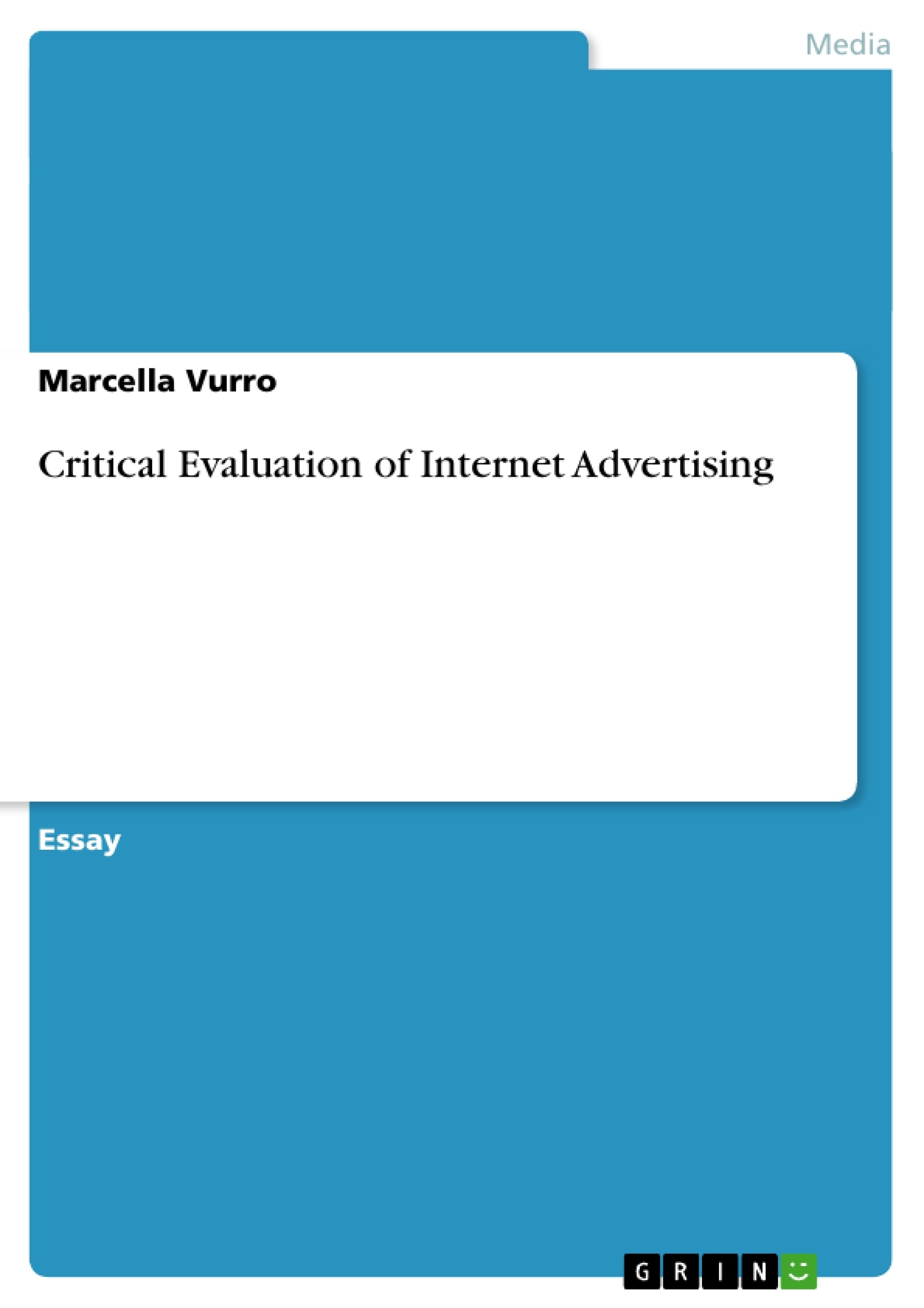Excerpt
Table of contents
1. Introduction
2. Methodology
3. Internet Advertising
3.2 Definition of Internet Advertising
3.3 Internet Advertising Prospects
3.4 Online Advertising Effectiveness
4. Online Advertising Instruments
4.1 Website/Microsite
4.2 Banner
4.3 E-mail Marketing
4.4 Web 2.0 applications
4.5 Keyword Advertising
4.6 Mobile
5. Advantages of Internet Advertising
6. Disadvantages of Internet Advertising
7. Conclusion
Bibliography
1. Introduction
The following essay is focussing on a critical evaluation of online advertising. It examines different online advertising instruments, such as banner, websites, keyword advertising etc. and identifies the advantages and disadvantages of online advertising.
2. Methodology
The methodological approach was defined by a review on topical literature on the subject-matter of internet advertising, mainly focussing on well-established tools, to enable a decision-making based on profound research results, but also acknowledging current online marketing trends to take advantage of new technologies such as mobile availability of websites, which will be further explained in detail. Different perspectives and expert opinions were considered, definitions researched and based on these findings a conclusion formulated. The essay will mainly focus on research studies focussing on the German market combined with general academic theory and empirical findings.
3. Internet Advertising
3.1 Problem Statement
Against the background of increasing competition and insecure markets companies are given the task to reduce costs in order to reduce their financial risks (PWC, 2009). A growing range of media capabilities associated with a growing range of advertising instruments impede the communication design additionally. Therefore a company, confronted with a variety of marketing possibilities, especially since the introduction of the internet and lately Web 2.0, needs to pose itself the question how to reach the target group in the most efficient and effective way with the appropriate advertising measures.
3.2 Definition of Internet Advertising
Before evaluating different definitions of online advertising, the internet as the fundament for online advertising by providing its technological platform, is defined in the following. The internet is an “international network of millions of computers that allows you to access and transmit information” (Price and Wix, 2002:1). It is a virtual place, were people globally come together to interact and exchange information. (Pleil and Zerfaß, 2007:511). On the basis of these statements internet advertising can be defined as follows: According to the Business Dictionary (Business Dictionary, 2009) internet advertising is the “Use of Internet as an advertising medium where promotional messages appear on a computer screen. Online advertising can be custom-tailored to match user preferences.” A different perspective on Internet advertising is presented by Schumann and Thorsen (Schumann and Thorsen, 2007:16), who claim that “Internet advertising is a multifaceted phenomenon… It spans time and space (unlike print, which is space bound and broadcast, which is time bound) and seems different in other fundamental ways as well (e.g. interactivity and the ability to personalize…)”. Derived from these 2 different approaches, that intend to narrow down the term of internet advertising, the essence is that the online medium can provide a flow of information available to consumers on demand enabled through technological devices in an interactive and personalized environment.
3.3 Internet Advertising Prospects
In contrast to current trends of decreasing marketing budgets, internet advertising is expected to grow further in the coming decade (approximately 7,7% p.a.) due to several reasons (DB Research, 2009:1). To begin with the growth of internet advertising follows the growth of internet usage in general. In 2003 only half of the German population were online; in the year 2009 this number had increased to two third of the German population (ARD/ZDF-Onlinestudie, 2009), which indicates a high affinity to then medium internet throughout Germany.
3.4 Online Advertising Effectiveness
According to a current ‘Focus’ study measuring the effects of online advertising between 2005 - 2009 with a panel of 17.509 participants, the following results were determined. The recognition of online advertising media is 5.2% higher compared to classic offline advertising media. The best performing online advertising media concerning recognition are videos and banner advertisement (medium rectangle, wallpaper, halfpage ad, skyscraper, superbanner) (Focus, 2009). The click-through rate is the standard measurement of internet advertising. The click- through rate has declined on a constant basis from 5% in 1998, but seems to have levelled out at 0.5% (Doubleclick, 2004). But there are new forms of evaluation that need to be considered such as post-impressions, which will be later explained in detail (see chapter “4.2 Banner”). There are several experts who consider that the effectiveness of online advertising depends on web motives (Raman and Leckenby, 1998; Rodgers and Thornton, 2000; Rodgers, 2002). Chandon and Chtourou (2001) investigated on the relationship between banner size and click-through-rate and found out that the click-through was positively affected by an increase in banner size. This was supported by Baltas (2003), who found that bigger advertisements had a better click-through, but Drèze and Hussherr (2003) found no relationship between the size of banner and brand recall, but they found out that brand recognition, unaided recall and awareness increase with exposure. Concerning frequency Dynamic Logic (2000) suggests that increasing frequency from 1 to 4 doubles the branding effect. These findings lead to the conclusion that banner sizes, although controversially discussed, should be high and banner schuld be exposed to the user at a frequency of 4.
[...]
- Quote paper
- Dipl. Kommunikations- und Marketingwirtin Marcella Vurro (Author), 2009, Critical Evaluation of Internet Advertising, Munich, GRIN Verlag, https://www.grin.com/document/142988
Publish now - it's free






















Comments